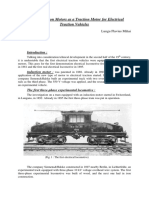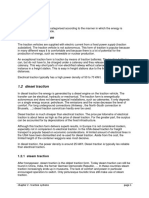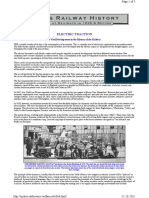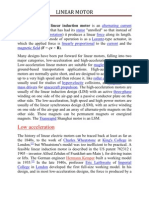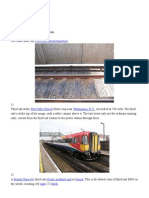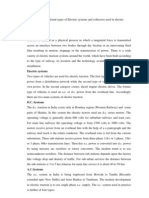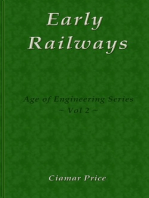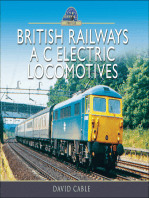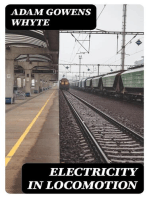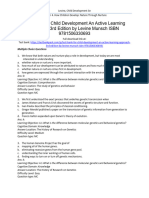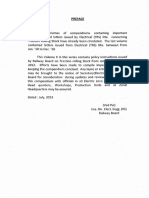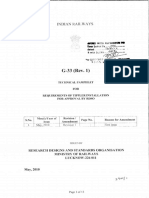Professional Documents
Culture Documents
A Review On Technology in Locomotives of Indian Railways: Rolga Roy, Stephy Johny & Arsha S
A Review On Technology in Locomotives of Indian Railways: Rolga Roy, Stephy Johny & Arsha S
Uploaded by
Aarsha PSOriginal Description:
Original Title
Copyright
Available Formats
Share this document
Did you find this document useful?
Is this content inappropriate?
Report this DocumentCopyright:
Available Formats
A Review On Technology in Locomotives of Indian Railways: Rolga Roy, Stephy Johny & Arsha S
A Review On Technology in Locomotives of Indian Railways: Rolga Roy, Stephy Johny & Arsha S
Uploaded by
Aarsha PSCopyright:
Available Formats
Imperial Journal of Interdisciplinary Research (IJIR)
Vol-2, Issue-5, 2016
ISSN: 2454-1362, http://www.onlinejournal.in
A Review on Technology in Locomotives
of Indian Railways
Rolga Roy1, Stephy Johny2 & Arsha S3
1
2,3
Assistant professor, Dept.of EEE, Sree Buddha College of Engineering for Women, India
UG Student, Dept. of EEE, Sree Buddha College of Engineering for Women,Kerala, India
.
Abstract: The most energy efficient motorized land
transportation system known to man is the operation
of trains on a railroad. In order to reduce the
dependence on petroleum based energy in railway
transport, Indian Railways have been progressively
switching over to Electric Traction. Railway electric
traction describes the various types of locomotives
and multiple units that are used on electrification
systems around the world. This paper considers the
evolution of technology inlocomotive, how dc
traction was replaced by single phase ac traction
and further by three phase ac. It focuses on advent of
electric traction in India, working principle of
electric multiple unit (EMU). In India we have
mainline electric multiple unit (MEMU) train, a high
speed electric train. And thereby this paper deals
with the difference between EMU and MEMU trains
.It also throws light on the progress of power
electronics in the field of electric locos
vastly energy efficient. The chief disadvantage of
electrification is the cost of infrastructure.
History
In the last 20 years there has been a gigantic
acceleration in railway traction development. This
has run in parallel with the development of power
electronics and microprocessors.
Electric traction was introduced on Indian
Railways in the year 1925 on 1.5KV DC and the first
electric train ran between Bombays Victoria
Terminus and Kurla along the Harbour line of CR,
on February 3,1925, a distance of 9.5 metres, flagged
off by then Governor of Bombay Sir Leslie Orme
Wilson.
I. Introduction
A train consists of a series of railroad cars with steel
wheels running along the steel rails of a railroad
track. The power to move a train usually comes from
one or more locomotives at the head of the train
pulling the cars behind it. There are two types of
locomotives today:
1: Diesel Electric
2: Electric
Locomotives in the US are usually powered by diesel
but elsewhere(especially in Europe) many
locomotives are electric and obtain electric power
from an overhead wire strung above the track. In this
paper the most relevant locomotive i.e Electric
Traction is analyzed. There is a wide variety of
electric traction systems around the world, which
have been built according to the type of railway, its
location and the technology available at the time of
the installation. Many installations seen today were
first built up to 100 years ago.A major advantage of
electric trains is that diesel trains may use a wide
variety of fuels such as coal. It results in lower
maintenance cost and lower energy costs. Electric
traction reduce the haulage of heavier loads at higher
speeds, thus increasing the output. It is a pollution
free system and with use of modern high horse
power locos having regenerative braking, it becomes
Imperial Journal of Interdisciplinary Research (IJIR)
Figure 1: One of the earliest DC EMUs in Mumbai
suburban area
In the year 1957, Indian Railways decided
to adopt 25KV 50Hz AC traction based on
French Railway technology. The first 25KV
AC electrified section was BurdwanMughalsarai, completed in 1957. The first
actual train run (apart from trial runs) using
25KV AC was on December 15,1959 on the
Dongaposi-Rajkharswan section.
Figure 2: Start of AC Electric Traction on 15th
December, 1959
Page 1560
Imperial Journal of Interdisciplinary Research (IJIR)
Vol-2, Issue-5, 2016
ISSN: 2454-1362, http://www.onlinejournal.in
Considering the advantages of 25KV AC system, it
was commissioned between Bina and Katni on
January 16,1995. This was later extended to
Bishrampur.
Electric locomotive
An electric train or an electric locomotive is a
locomotive powered by electricity from an external
source. External sources may include overhead lines,
third rail, or an on-board electricity storage device
such as a battery or flywheel system.
There are two basic types of Railway Electrification:
1: DC (Direct Current)
2: AC (Alternating Current)
Direct Current (DC) traction units use direct
current drawn from either a conductor rail
or an overhead line. AC voltage is
converted into DC voltage by using
rectifier.
Alternating Current (AC) traction units
draw alternating current from an overhead
line.
Most urban rail transit uses DC to run without
locomotives, each car having its own motors. In
order to have an efficient power distribution system,
a much higher voltage is desirable in the overhead
lines than the voltage required to operate the motors.
Thus modern locomotives contain devices to reduce
the voltage to that suitable for the motors. DC
voltages are usually 600 to 3000 volts, while AC is
usually 12000 to 25000 volts. With 3000 volts DC it
is possible to put 4 traction motors in series and get
only 750 volts on each motor.
In India,1500V DC and 25kV AC, 50Hz is used for
main line trains. The 1500V DC overhead system is
used around Mumbai. The Mumbai region is the last
bastion of 1500V DC electrified lines on Indian
Railways.
Electric currents create magnetic fields to which
people are exposed. Advantage of DC over AC is
that DC currents create a steady magnetic field and
are thought to pose no hazard to health whereas AC
fields may increase the risk of leukemia in children.
II. Three Phase Technology
After reaching a power level of 5000HP, there was
no further scope for up-gradation with minimal
inputs in the dc drive locomotives, as the capacity of
equipment in the traction chain was fully utilized.
Any further upgradation needed a total new design.
During the late 80s development took place in
developed railways towards three phase induction
motor based drives for traction due to the distinct
advantages of less maintainence intensiveness in
comparision to dc drives. Induction motor drives are
also known for extremely effective regeneration,
thereby reducing the energy cost. A new variant
Imperial Journal of Interdisciplinary Research (IJIR)
WAP7 was intended for passenger operation for
service speeds upto 130KM/hr, which is the
maximum speed of Rajdhani and Shatabdi trains
today.
Advantages of three phase locos:
Better reliability and availability of three
phase locos.
It regenerates energy about 15-18%, a
moving power house. Regeneration of
power is available in three phase
locomotives. Regenerative braking effort is
available from the full speed till dead stop.
Consequently, the overall efficiency of
operation is higher.
Maintenance cost of a three phase
locomotive is less due to the absence of
brush-gear/commutator in the traction
motors and switch gears in the power
circuit.
Three phase locomotives operates at near
unity power factor throughout the speed
range except at very low speeds.
III. Mainline Electric Multiple Unit
(Memu) Trains
The recent development of the Mainline EMU
(MEMU), manufactured by ICF was intended to
address precisely this, to allow EMU operations in
more areas. They have a width of 108. MEMUs
run on 25kV AC power. MEMU driving motor
coaches seat 76 and the trailer coaches seat 108.
They have a rated speed of about 105km/h and are
equipped with electro-pneumatic brakes, the trailer
coaches weigh about 33.6 tonnes and the motor
coaches weigh about 60 tonnes. Earlier versions of
MEMUs have a top speed of 60km/h. RDSO
improved on these by increasing the horsepower of
the traction motors and providing a weak field
arrangement in them for higher speeds.
MEMU trains are designed for semi-urban and
rural areas, unlike EMU (electric multiple unit)
trains that are designed for urban and semi-urban
areas. MEMU trains also have end vestibules
(gangway connections) that are not found
on EMU trains. In EMUs one power car is required
for 3 coaches. So for an EMU 12 coaches in length
will have 4 power cars. So MEMU trains generate
more power (or they are more powerful) than EMU
trains. Thats why MEMUs are normally 16-20
coaches long whereas EMUs are generally of 12
coaches only. MEMU trains run on main line where
normal passengers dont. EMU are slower than
MEMU.
IV. Electric Multiple Unit (Emu):
Electric trains in big cities are called EMU, electric
multiple unit trains. The term multiple unit is used to
describe a self-propelling train unit capable of
Page 1561
Imperial Journal of Interdisciplinary Research (IJIR)
Vol-2, Issue-5, 2016
ISSN: 2454-1362, http://www.onlinejournal.in
coupling with other units of the same or similar type
and still being controlled from one cab. In the year
1893, the first EMUs were used on the
elevated Liverpool Overhead Railway. It had two
carriages and later got extended to three carriages,
with the front and rear carriages powered.Majority of
EMUs have nine or twelve coaches and sometimes
even fifteen to handle rush hour traffic. In EMU's 1
power car is required for 3 coaches so for an EMU
12 coaches in length will have 4 power cars. Most
EMUs are used as passenger trains, but some are also
specialized for non-passenger roles, such as carrying
mail or luggage. EMUs are popular in railways
because of their fast acceleration and pollution-free
operation.
V. Power Supply
The electric railway needs a power supply that the
trains can access at all times. It must be safe,
economical and user friendly. It can use either DC
(direct current) or AC (alternating current), the
former being, for many years, simpler for railway
traction purposes, the latter being better over long
distances and cheaper to install but, until recently,
more complicated to control at train level.
Transmission of power is always along the track by
means of an overhead wire or at ground level, using
an extra, third rail laid close to the running rails.
Figure: DC 3-Rail Traction System
The above diagram shows a DC 3-Rail Traction
System with the location of the current rail in
relation to the running rails. The third rail system
uses a "shoe" to collect the current on the train. In
AC systems, the supply of electricity is through an
overhead system of suspended cables or wires known
as the catenary. A contact wireor contact cable
actually carries the electricity. It is suspended from
or attached to other cables above which it ensures
that the contact cable is at a uniform height and in
the right position. DC can use either an overhead
wire or a third rail; both are common. Both overhead
systems require at least one collector attached to the
train so it can always be in contact with the power.
Overhead current collectors use a "pantograph", so
called because that was the shape of most of them
until about 30 years ago. The return circuit is via the
Imperial Journal of Interdisciplinary Research (IJIR)
running rails back to the substation. The running rails
are at earth potential and are connected to the
substation. Pantograph is a metal structure which can
be raised or lowered to make contact with the
overhead contact cable and draw electricity from it to
power its motors. (Usually it goes first through a
transformer and not directly to the motors.) It is held
up by compressed air pressure. It is designed to
collapse if it detects an obstruction. It can also be
lowered manually to isolate the locomotive or train.
The pantograph has one or two blades, shoes or
collector pans that actually slide against the contact
wire. It has the following characteristics:
It must remain in continuous contact with
the overhead wire while the EMU is
running.
It must not abrade the overhead wire and
neither must it be subject to excessive wear.
It must have low aerodynamic resistance.
VI. Working Of EMU
Catenary and pantograph together transmit the
electricity required to power the motor of an electric
train. Electricity is fed to the catenary via
substations. When the pantograph enters into the
contact with the catenary, its as if the train was
plugging itself into the circuit. The pantograph is a
system of articulated arms fixed to the roof of
locomotive. It holds and extends along a vertical
axis, its horizontal end piece is called as the head.
This head is fitted with carbon strips. Their number
and type depends on nature and intensity of current
to be transmitted; DC or AC for example. These
carbon strips slide along the catenary contact wire,
thus capturing the electricity required to power the
trains traction motor. The catenary is more complex
than a simple power cable minimum it is made up of
messenger cables, contact wires, droppers, steady
arms and tensioning devices. All these are supported
at regular intervals. The catenarys architecture is
designed so that even at high speed, contact between
the catenary contact wire and the pantograph is
permanent and uninterrupted. The cables of the
overhead lines are so heavy that suspended between
two points they do not form a straight line but sga
due to their weight. For speeds about 60km/h and in
order to guarantee a continuous contact between the
catenary and the head of the pantograph thus
avoiding excessive power loss, the catenary contact
wire must be maintained in a horizontal position. It
must also be rigid enough to interact in a dynamic
way with the pantograph. The solution is that the
contact wire is supported at regular intervals with the
droppers. Due to these droppers and tensioning loads
the contact wire is maintained in the horizontal axis
with a controlled level of rigidity. These droppers
have variable lengths calculated in accordance with
Page 1562
Imperial Journal of Interdisciplinary Research (IJIR)
Vol-2, Issue-5, 2016
ISSN: 2454-1362, http://www.onlinejournal.in
several parameters such as the tensioning loads of the
contact and messenger wires or their mechanical
characteristics. Almost 10,000 kms of catenary wires
have been installed worldwide.
VII. Conclusion
Electric trains reduce the dependency on fossil fuels,
run on higher speed and thus are more efficient. In
comparison to the principal alternative, the diesel
engine, electric railways offer substantially better
energy efficiency, lower emissions and lower
operating costs. The recent development of the Mainline EMU (MEMU), manufactured by ICF is more
powerful than EMU. EMU (electric multiple unit)
trains are designed for urban and semi-urban areas.
Electric locomotives are usually quieter, more
powerful, and more responsive and reliable than
diesels. Electricity is typically generated in large and
relatively efficient generating stations, transmitted to
the railway network and distributed to the trains.
Electrification has many advantages but requires
significant capital expenditure. Selection of an
electrification system is based on economics of
energy supply, maintenance, and capital cost.
Reference
1. https://en.wikipedia.org/wiki/Traction_moto
r
2. https://en.wikipedia.org/wiki/Electric_multi
ple_unit
3. https://www.railelectrica.com
4. https://en.wikipedia.org/wiki/MEMU
5. https://en.wikipedia.org/wiki/Railway_electr
ic_traction
Imperial Journal of Interdisciplinary Research (IJIR)
Page 1563
You might also like
- Service Manual GT46 MACDocument887 pagesService Manual GT46 MACmadhwan sharma100% (3)
- Mining Machinery Nit RourkelaDocument343 pagesMining Machinery Nit RourkelaNaren Gujjar100% (8)
- 331 Frey S Railway Electrification Systems EngineeringDocument145 pages331 Frey S Railway Electrification Systems Engineeringdanutzughe100% (1)
- Maglev TrainsDocument19 pagesMaglev TrainsJohn K95% (19)
- Illustrated Encyclopedia of World Railway LocomotivesFrom EverandIllustrated Encyclopedia of World Railway LocomotivesRating: 3.5 out of 5 stars3.5/5 (2)
- A Great Shining Road The Epic Story of The Transcontinental RailroadDocument372 pagesA Great Shining Road The Epic Story of The Transcontinental RailroadBrandon RojasNo ratings yet
- Failuer Analysis Crankshaft in Diesel LocomotiveDocument74 pagesFailuer Analysis Crankshaft in Diesel LocomotivePankajBhamareNo ratings yet
- Electric Locomotive and Traction Installation: (A Central University)Document22 pagesElectric Locomotive and Traction Installation: (A Central University)ajay bhaskarNo ratings yet
- Project Report On Electric Loco, TuglakabaadDocument39 pagesProject Report On Electric Loco, TuglakabaadSaurabh Madeel88% (8)
- Electric LocomotiveDocument45 pagesElectric LocomotiveBhushan MandvalNo ratings yet
- Electic LocoDocument20 pagesElectic LocoNitishBHATIANo ratings yet
- Railway Electric Traction - WikipediaDocument13 pagesRailway Electric Traction - WikipediasajalNo ratings yet
- Electric Train (Guardado Automaticamente)Document11 pagesElectric Train (Guardado Automaticamente)CANAL JFNo ratings yet
- Electric TractionDocument22 pagesElectric TractionRubia IftikharNo ratings yet
- Traction IntroductionDocument21 pagesTraction Introductionc_h_v_k_rNo ratings yet
- Tesla's Electric MotorsDocument5 pagesTesla's Electric MotorsFlavius LunguNo ratings yet
- Electric Traction Presented By: Piyush Kumar 10EEE023Document23 pagesElectric Traction Presented By: Piyush Kumar 10EEE023nagarjunareddy100% (1)
- Seminar Report On Inidan RailwaysDocument35 pagesSeminar Report On Inidan RailwaysMohd DanishNo ratings yet
- Ac Electric LocomotiveDocument12 pagesAc Electric LocomotiveTahamee SHAIKHNo ratings yet
- Electric TractionDocument23 pagesElectric Tractionyatendra kashyapNo ratings yet
- Case Study2Document16 pagesCase Study2Darshan ParmarNo ratings yet
- Eeeb283 Group Project - Study On ElectriDocument15 pagesEeeb283 Group Project - Study On ElectrimoisesramosNo ratings yet
- A044010114 PDFDocument14 pagesA044010114 PDFRahul KusumaNo ratings yet
- Diesel LocomotiveDocument74 pagesDiesel LocomotiveVikas GuptaNo ratings yet
- A Brief History and Theory Behind Ac, DC and Maglev TrainsDocument7 pagesA Brief History and Theory Behind Ac, DC and Maglev TrainsmuratNo ratings yet
- Electric Multiple UnitDocument3 pagesElectric Multiple Unitranjanids7No ratings yet
- Electric LocomotiveDocument33 pagesElectric LocomotiveAbhinandan KumarNo ratings yet
- Electric Locomotive - WikipediaDocument48 pagesElectric Locomotive - WikipediaDeepali JadonNo ratings yet
- Railway Technology - Chapter 2 - Traction Systems - 2019-02-13Document7 pagesRailway Technology - Chapter 2 - Traction Systems - 2019-02-13Blaise PascalNo ratings yet
- Maharashtra Stateboard of Technical Education: CertificateDocument13 pagesMaharashtra Stateboard of Technical Education: CertificateTahamee SHAIKHNo ratings yet
- Electric Traction: A Vital Development in The History of The RailwayDocument5 pagesElectric Traction: A Vital Development in The History of The RailwayRaghavan Veera SundaramNo ratings yet
- The Behavior of Traction System of AC 25 KV During OperationDocument18 pagesThe Behavior of Traction System of AC 25 KV During OperationSano Sanoj100% (1)
- Highspeed TrainDocument22 pagesHighspeed TrainAbhimanyu Singh Bhati100% (1)
- A Linear Motor or Linear Induction Motor Is An Alternating CurrentDocument6 pagesA Linear Motor or Linear Induction Motor Is An Alternating CurrentAnand KanaujiyaNo ratings yet
- Maglev Trains 2Document14 pagesMaglev Trains 2Aadi AgrawalNo ratings yet
- AC & DC Railway System in MalaysiaDocument11 pagesAC & DC Railway System in MalaysiaMuhammad UmairNo ratings yet
- Chapter III EditedDocument43 pagesChapter III EditedthreephasefaultNo ratings yet
- 0 Steimel-1 PDFDocument8 pages0 Steimel-1 PDFIngeniumDemNo ratings yet
- Electric TractionDocument25 pagesElectric Tractionrio_olNo ratings yet
- PratikDocument16 pagesPratikAkshayNo ratings yet
- RailwaysDocument5 pagesRailwaysAnkur BansalNo ratings yet
- Project On Maglev Train Class 12Document30 pagesProject On Maglev Train Class 12vishwhaajeaayNo ratings yet
- Railway Traction System: Current Status and ApportunitiesDocument10 pagesRailway Traction System: Current Status and ApportunitiesSiddesh SanjuNo ratings yet
- Electric Train SystemDocument23 pagesElectric Train SystemQuynh Mai Do Le100% (1)
- Third RailDocument20 pagesThird RailrhusmenNo ratings yet
- Sky BusDocument3 pagesSky BusRavitheja ReddyNo ratings yet
- Project Report On Electric Loco ShedDocument38 pagesProject Report On Electric Loco Shedjohn power100% (1)
- Rolling StockDocument27 pagesRolling StockJizelle HascoNo ratings yet
- About Maglev Train PDFDocument15 pagesAbout Maglev Train PDFPiyush BhartiNo ratings yet
- CCCCCCC: C C C C CCCC CDocument18 pagesCCCCCCC: C C C C CCCC ChumrahulNo ratings yet
- Submitted By: Janmejaya Sahu Regd No:0801214182 Branch: Electrical Date: 6 Sept, 2011Document15 pagesSubmitted By: Janmejaya Sahu Regd No:0801214182 Branch: Electrical Date: 6 Sept, 2011Dev KumarNo ratings yet
- Expt No.6 Electric TractionDocument7 pagesExpt No.6 Electric TractionPriyanka MauryaNo ratings yet
- Introduction To Railroad EngineeringDocument15 pagesIntroduction To Railroad EngineeringChristian RigonNo ratings yet
- Jaipur National University, JaipurDocument30 pagesJaipur National University, JaipurPatel DipenNo ratings yet
- Hotel Load in Indian Railways Energy Conservation in EOG SchemeDocument3 pagesHotel Load in Indian Railways Energy Conservation in EOG SchemeDeepak GehlotNo ratings yet
- LocomotiveDocument19 pagesLocomotiveanulekha1991No ratings yet
- I'll Take the Plane, the Bus and the Train 'Til I Get There! Travel Book for Kids | Children's Transportation BooksFrom EverandI'll Take the Plane, the Bus and the Train 'Til I Get There! Travel Book for Kids | Children's Transportation BooksNo ratings yet
- Electricity in Locomotion: An Account of Its Mechanism, Its Achievements, and Its ProspectsFrom EverandElectricity in Locomotion: An Account of Its Mechanism, Its Achievements, and Its ProspectsNo ratings yet
- The Southern Region (B R) Class 73 and 74 Locomotives: A Pictorial OverviewFrom EverandThe Southern Region (B R) Class 73 and 74 Locomotives: A Pictorial OverviewNo ratings yet
- Train Simulator 2013 Keyboard Signal GuideDocument2 pagesTrain Simulator 2013 Keyboard Signal GuideAnonymous HGOomkn69No ratings yet
- ALCO Loco RelaysDocument16 pagesALCO Loco RelaysMuhammathali JNo ratings yet
- Hydrostatic Transmission For Shunting LocomotivesDocument16 pagesHydrostatic Transmission For Shunting LocomotivesDIPAK VINAYAK SHIRBHATE100% (1)
- S S ProjectDocument114 pagesS S ProjectBharadwaj SrinivasanNo ratings yet
- Friction Resistance On Train WheelsDocument16 pagesFriction Resistance On Train WheelsNatarajan RamakrishnanNo ratings yet
- Spec No - MP-0-2400-53-June-08 - (EOTT)Document15 pagesSpec No - MP-0-2400-53-June-08 - (EOTT)hima_bindu_89No ratings yet
- Arun Final ProjectDocument138 pagesArun Final ProjectInkpen studiousNo ratings yet
- Rtis PDFDocument2 pagesRtis PDFPrashanth SagarNo ratings yet
- Geismar General Presentation - May 2019 - V12Document19 pagesGeismar General Presentation - May 2019 - V12GEISMAR IndiaNo ratings yet
- Child Development An Active Learning Approach 3Rd Edition Levine Test Bank Full Chapter PDFDocument36 pagesChild Development An Active Learning Approach 3Rd Edition Levine Test Bank Full Chapter PDFmatthew.templeton879100% (19)
- Dokumen - Tips - Computer Graphics Project The Running TrainDocument19 pagesDokumen - Tips - Computer Graphics Project The Running TrainPruthvir ShettyNo ratings yet
- CMR Engineering Solutions GuideDocument9 pagesCMR Engineering Solutions GuideJun OrtizNo ratings yet
- Cargo Containers, Rail Cars, Trailers, and TrucksDocument11 pagesCargo Containers, Rail Cars, Trailers, and TrucksBryan VertuodasoNo ratings yet
- Electrical Energy Utilisation and Management - Electric TractionDocument42 pagesElectrical Energy Utilisation and Management - Electric Tractionmadhu balanNo ratings yet
- VT ReportDocument36 pagesVT ReportafNo ratings yet
- Electric Traction: A Seminar OnDocument20 pagesElectric Traction: A Seminar OnEmmaniel rock100% (2)
- Compandium 2012Document107 pagesCompandium 2012dycmmNo ratings yet
- Train Resistance and Tractive PowerDocument20 pagesTrain Resistance and Tractive PowerKazi Monirul IslamNo ratings yet
- Shakurbasti Diesel Shed Report NewDocument25 pagesShakurbasti Diesel Shed Report NewDeepak Chandhok100% (1)
- Bheem: 5500 HP Freight LocomotiveDocument18 pagesBheem: 5500 HP Freight LocomotiveP. S. VENUGOPALNo ratings yet
- Trainset - What, Why, How SBD (IRIMEE) - 2022Document58 pagesTrainset - What, Why, How SBD (IRIMEE) - 2022Subrato NathNo ratings yet
- Microsoft Train Simulation GuideDocument96 pagesMicrosoft Train Simulation Guideduta01No ratings yet
- Electric and Diesels On The Southern at HavantDocument21 pagesElectric and Diesels On The Southern at HavantRalph CousinsNo ratings yet
- Tanzania Transport Master Plan (Vol.3)Document324 pagesTanzania Transport Master Plan (Vol.3)Julius Enock MoshiNo ratings yet
- DB Class 185.2 Traffic Red Expert-Line: Compatible With Train Simulator 2015 or LaterDocument18 pagesDB Class 185.2 Traffic Red Expert-Line: Compatible With Train Simulator 2015 or LaterAlexandru PopaNo ratings yet
- RDSO Guidelines G 33 Rev 1 PDFDocument29 pagesRDSO Guidelines G 33 Rev 1 PDFjacs127No ratings yet















